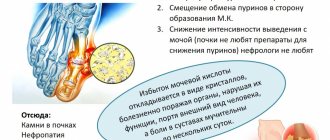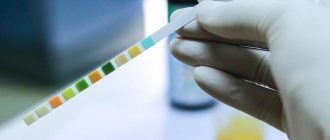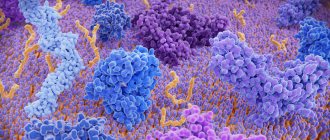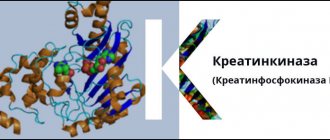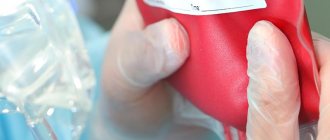GGTP - what kind of compound is it and what functions does it perform?
What is this?
GGTP stands for gamma-glutamyl transpeptidase. Sometimes this indicator is called GGT, which stands for gamma-glutamyl transferase. Both of these names refer to the same enzyme.
Where is it formed
This enzyme can be found in the nephron tubules of the kidneys, in the epithelium lining the bile ducts. Most of it is found in liver cells. Therefore, when these tissues are damaged, the enzyme enters the blood, which allows the doctor to diagnose a malfunction of these organs.
Main functions
Glutamyltransferase is an enzyme. And the main role of an enzyme is to catalyze any reaction. GGT catalyzes reactions that transfer glutamyl to amino acids or other compounds. This transfer is very important in the metabolism of amino acids: the enzyme promotes their transport, for example, through the intestinal wall from its lumen into the blood.
When is a test to determine GGTP prescribed?
The determination of this type of transferase can be prescribed separately or in combination with other liver enzymes, for example, aspartate aminotransferase or alanine aminotransferase, to diagnose the condition of the hepatobiliary tract.
This enzyme has great diagnostic value in diagnosing diseases of the liver and biliary tract in such categories of people as children and pregnant women, since other liver enzymes increase at a physiological level.
Glutamyl transpeptidase activity also increases when the liver is exposed to toxic substances, such as certain medications or alcohol. This way you can understand whether the liver damage was caused by alcohol or not.
Glutamyltransferase is not found in bones. Accordingly, the level of GGT will not be affected by bone tissue pathology. This allows us to search for reasons for the increase in another enzyme - alkaline phosphatase.
Alkaline phosphatase is a diagnostic indicator of bone tissue pathology or damage to the hepato-biliary system.
GGT also makes it possible to assess the state of the kidneys, and if their functioning is disrupted, this enzyme will indicate this to the doctor.
Thus, gamma-glutamyltransferase makes it possible to carry out differential diagnosis of conditions that cause disruption of the liver, pathology of the kidneys and biliary tract.
Additional examinations
Supporting activities are needed to get to the bottom of the phenomenon. That is, to determine what caused the increase in indicators. This is the task of gastroenterology specialists. Less common are nephrologists - doctors who work on kidney problems.
An approximate list of studies would be:
- Oral interview and history taking. As part of the initial consultation.
- Ultrasound of the liver. Detailed, with examination of the gallbladder.
- Scintigraphy. Radioisotope technique. Aimed at assessing the condition of the largest gland in the body.
- MRI. Those structures that are most likely affected. The question of localization of the probable process remains with the doctor.
- Ultrasound of the kidneys.
- Ultrasound examination of the structures of the prostate gland and the pelvis in general.
- Study of urine.
- PCR, ELISA tests for a probable infectious process.
GGT in a biochemical blood test is a nonspecific indicator of damage to the kidneys, liver, and less commonly the digestive tract. It is examined in a standard laboratory test. This is an informative level that gives hints to the doctor.
Preparing for analysis
How to prepare?
The determination of gamma-glutamyltransferase refers to a number of biochemical blood tests. In order to obtain accurate information about GGT in the body, the patient must properly prepare for blood donation.
The preparation rules are very simple:
- For biochemical studies, blood should be donated on an empty stomach, that is, after an overnight fast for 10–12 hours. This way you can be sure that the blood will be suitable for research and will reflect the exact content of the test indicator in the blood;
- It is recommended not to smoke for several hours before blood collection;
- emotional experiences a day before the analysis can affect the accuracy of the research results;
- training and other physical overload of the body should be cancelled. They can also affect the final result;
- If the patient is prescribed medications, then you should consult a doctor - can they affect the level of the enzyme in the blood? The patient should not cancel or prescribe anything on his own!
Where is it for rent?
Blood sampling to determine the level of glutamyl transferase takes place in a special room at a medical institution. Most often this is a local clinic. This simple analysis can also be carried out in private medical organizations.
Price
When visiting a clinic at your place of residence, the determination of gamma-glutamyl transferase is carried out free of charge for patients with a compulsory medical insurance policy. If the patient expressed a desire to donate blood to determine the level of this enzyme in a private medical center, then the price for this analysis will be about 150 - 300 rubles.
Please remember that there is an additional charge for the blood collection procedure itself. On average, this will be about 150 – 300 rubles, depending on the region.
How is GGT tested?
The GGT study is included in the biochemical blood test and is included in the group of liver tests. For the determination, human biological material (blood) is used, which is donated on an empty stomach, since with the consumption of food there is an increase in enzyme activity, which will lead to false results.
Blood is drawn from a vein.
It is very important to follow all the preparation steps before having a blood test so that you do not have to do it again.
The GGT level is recorded at different temperatures of the incubation sample and using different methods. The choice of method and temperature used depends directly on the laboratory in which the patient is tested and the equipment installed in them.
As a result of the analysis, next to the GGT indicator the temperature at which the study was carried out is noted. So, deciphering the analysis can only be done by an experienced doctor, since in addition to the temperature and method of examination, it is necessary to take into account the gender, age, and race of the patient.
To avoid false indicators in the final results table, it is recommended to follow preparation measures. By following the rules listed below, the results will be the most reliable, which will help to correctly diagnose or refute the disease.
The main recommendations for preparation are:
- ACCP for rheumatoid arthritis: norm, analysis, interpretation
- Blood is donated on an empty stomach. To avoid deviations in blood counts caused by activation of enzymes due to food intake. The consumption of foods is limited at least eight hours (preferably more than ten) before the time of blood sampling. That is why the test is taken in the morning, since a person will not feel hungry at night. It is also prohibited to drink any drinks, including ordinary drinking water,
- Refuse to eat fatty, highly salted, spicy, overcooked foods that are difficult for the body for at least twenty-four hours (preferably forty-eight hours). Such products have too strong an effect on enzymes, significantly increasing the indicators
- to stop playing sports and avoid strenuous physical activity as much as possible , two days in advance, since physical effects on the body also affect the final results,
- A visit to a sauna, steam bath, or hot bath the day before can lead to fluctuations in normal values. You should avoid visiting places where the body is exposed to thermal effects,
- Limit alcohol intake and cigarette consumption at least 24 hours before the upcoming test.
- Stop using medications at least two days before the test. Drugs of certain groups can affect the parameters of a biochemical blood test. If it is not possible to stop using medications, you must inform your doctor about the use of medications. The doctor will make adjustments to the results, taking into account the effect of a particular drug on human blood,
- Come to donate blood 10-15 minutes in advance . This is necessary so that the body calms down, shortness of breath goes away, and the body acclimatizes to the temperature conditions of the room (especially after a cold street).
Fact! If you are very hungry, it is better to take food with you and satisfy your hunger immediately after blood collection.
What could affect the results?
In addition to liver disorders, the following factors may affect a normal result, leading to a false reading. These include:
- Long-term use of ascorbic acid can significantly reduce the GGT result,
- Elevated GGT levels are provoked by antibiotics, antidepressants, oral contraceptives, aspirin, paracetamol, testosterone and certain types of medications,
- Excessive excess weight.
Fact! When deciphering the analysis, it is also important to take into account other indicators in the biochemical blood test (lipase, LDH, bilirubin, ALT, AST, etc.), since almost all GGT deviations are accompanied by disturbances in the levels of other enzymes. ALT and AST are elevated, then the pathology is confirmed.
Analysis transcript
Norm for men and women
The normal range of gamma-glutamyltransferase levels differs between men and women. The norm for women is no more than 30 units per liter (U/L), and for men – no more than 50.
The reference values are provided for informational purposes only. You should not try to decipher the analysis results yourself. Let a specialist handle this.
Also, only approximate norms of GGTP were given above. In each laboratory, standards may differ depending on which test systems are used to determine the activity of this enzyme in blood serum.
Taking this into account, it is better to study GGT levels over time in the same clinical diagnostic laboratory.
Norms for children
Normal GGT levels are higher in children than in adults and vary depending on the age of the child.
In the first week of a child's life, the GGTP level should not exceed 180 units per liter. Then the enzyme level can increase, but not more than 200 units during the first half of the year.
By the first year of a child’s life, the level of gamma-glutamyl transferase decreases to a level of no more than 35 units per liter. During the growth and life of a child, the level of glutamyl transferase does not change much. Around the age of twelve, normal levels of the enzyme become the same as for an adult.
How is a blood test for Gamma GT performed?
A biochemical blood test for GGT is always prescribed to test for sensitivity to alcohol.
However, the study can be carried out in a number of other cases:
- during preoperative preparation;
- when diagnosing liver problems;
- when the patient develops alarming symptoms: nausea, vomiting, weakness, pain in the right hypochondrium;
- if signs of cirrhosis or hepatitis occur;
- to confirm detected oncology.
How to prepare?
As a rule, blood is taken from a vein for analysis.
To obtain the correct result, the patient must adhere to several recommendations:
- since blood is taken on an empty stomach, eat no later than 8 hours before the time of analysis;
- exclude alcohol and foods with a high fat content from the diet 2-3 days before the test;
- do not expose the body to intense physical activity;
- temporarily stop taking medications after the prior consent of the doctor;
- additional studies (ultrasound, x-ray, etc.) and physiotherapeutic procedures should be carried out after the test.
Norm
The average standards are:
- for men – up to 49 U/l;
- for women – up to 32 U/l.
In children, standard indicators depend on age and gradually decrease. The highest level of GGT is in newborns. Until the age of 12, the indicators for boys and girls are approximately the same, then puberty begins, and the standard for boys gradually increases.
Deviation from the norm
A change in the activity of the enzyme glutamyltransferase above the reference values indicates pathology. In addition to diseases, taking medications can cause the indicator to deviate from the norm, but more on that later.
The higher the enzyme activity in the blood, the more severe the patient’s condition.
What causes GGTP levels to increase?
There are a number of pathologies of the liver and biliary tract that are accompanied by increased activity of gamma-glutamyl transpeptidase. These include:
- disruption of the outflow of bile through the ducts due to blockage of the lumen by a stone or tumor, which causes the development of mechanical (obstructive or subhepatic) jaundice in the patient;
- liver damage caused by alcohol, such as hepatitis;
- replacement of liver tissue with connective tissue, which is called cirrhosis;
- pancreatitis - inflammation of the pancreas;
- autoimmune damage to the liver and bile ducts;
- diabetes;
- liver damage due to infectious mononucleosis;
- liver cancer;
- kidney pathology, for example, chronic renal failure.
Correction approaches
Only a doctor can adjust the level of gamma-glutamyltransferase. After analyzing the data from other test results, he will be able to find out the cause and carry out competent treatment of the primary disease. After treatment, the enzyme level will return to normal.
For example, if increased GGT activity is caused by high alcohol consumption, then when you stop drinking it, the enzyme level will return to normal.
What is GGT in a blood test?
Gamma glutamyl transferase (synonym: gamma glutamyl transpeptidase) is the name of a microsomal enzyme involved in amino acid metabolism. It is located on the cytoplasmic membranes (walls) of cells that perform secretory and absorption functions. Important. The enzyme is most active in the kidneys, liver and pancreas.
In the cells of the intestines, brain, heart, spleen and prostate, little activity of gamma-glutamyl transpeptidase (abbreviated GGTP or GGT) is observed. In a healthy person, GGT is found in blood cells in minimal quantities, this is due to the normal process of cell renewal in the body. However, an increase in the amount of this enzyme in the bloodstream is always associated with pathological processes and indicates the destruction of the cells in which it is contained.
Given the high concentration of GGT in the tissue of the kidneys, liver and pancreas, it is considered a sensitive marker of diseases of these organs. Gamma glutamyltransferase reacts most quickly and vividly to damage to the hepatobiliary system.
Important. When diagnosing cholecystitis, cholangitis (inflammatory process in the bile ducts) and mechanical jaundice (GGT also acts as a marker of bile stagnation), an increase in this enzyme is even more specific than an increase in ALT and AST.
Functions of the GGT
Gamma glutamyltransferase is involved in the processes:
- amino acid metabolism;
- metabolism of mediators of inflammatory reactions.
Although GGT concentrations in the renal epithelium are higher than in the liver, serum concentrations (determined in the blood) are predominantly of hepatic origin. Most of the GGT destroyed in the kidneys is excreted in the urine.
What can lead to improved results, besides diseases?
Elevated gamma-glutamyltransferase levels can be caused by alcohol abuse on the eve of a blood test. It was also previously mentioned that some drugs can affect the results of the study, inflating the actual values.
Such medicines include:
- barbiturates;
- statins are a group of drugs used to lower blood cholesterol levels;
- antidepressants;
- some types of antibiotics;
- oral contraceptives and some other hormonal drugs;
- Aspirin, Paracetamol.
Also noted is the fact that in obese individuals the level of the enzyme will be higher than normal. The doctor should take this into account when interpreting the study results.
Hyperlipoproteinemia - symptoms and treatment
Diet
If the patient has no symptoms, then treatment begins with a special diet.
Correction of nutrition can reduce cholesterol levels by 5–10%. Recommended:
- Eat less animal fat (up to 30% of daily calories).
- Include vegetable oils in your diet: sunflower, olive and cottonseed (up to 25–30 mg per day). They are a source of polyunsaturated fatty acids, which normalize cholesterol metabolism.
- Eat fewer foods rich in cholesterol: liver, kidneys, brains, fatty meats, egg yolks, mayonnaise, fatty sauces.
- Do not fry the meat, but boil it, but avoid very rich broths.
- Eat no more than 40–50 g of sugar per day, limit consumption of sweets, cakes, pastries, sugary drinks and fruit nectars. Excess sugar contributes to the development of atherosclerosis.
- Drink freshly squeezed juices from apples, oranges and carrots 1-2 times a week.
- Do not indulge in strong tea and coffee, as they can increase blood pressure, cause palpitations and insomnia.
- Eat no more than 3–5 g of salt per day.
- There are more vegetables, fruits, cereals (especially rolled oats) and wholemeal products.
- Eat fish twice a week, steaming or grilling it.
- Season salads with olive oil, lemon juice, herbs and spices [3].
It is important to remember that cholesterol not only comes from outside, but is also formed in the body. Therefore, you should not completely give up foods containing fats.
Drug treatment
For cardiovascular diseases, diabetes mellitus, chronic kidney disease and a high risk on the SCORE scale, cholesterol-lowering medications are indicated. However, in some cases, patients even at moderate risk may require drug therapy. It will help reduce the likelihood of developing atherosclerosis.
To correct the level of atherogenic lipids, drugs are taken for a long time, most often for life. When LDL levels are reduced, the risk of cardiovascular disease decreases by 30–40% [9].
Groups of drugs for the treatment of hyperlipoproteinemia:
- statins;
- fibrates;
- inhibitors of cholesterol absorption in the intestine;
- bile acid sequestrants;
- PCSK9 enzyme inhibitors;
- n-3 fatty acids [8].
Statins
Statins (Atorvastatin, Rosuvastatin, Pitavastatin) are the most effective drugs for lowering cholesterol. They block the enzyme that is involved in its formation and thereby suppress the production of cholesterol in the liver. Statins reduce low-density lipoprotein (LDL) and triglycerides (TG).
Statins prevent the development of atherosclerosis of the coronary and cerebral arteries, and with long-term use they reduce the size of plaques in the vessels. These drugs are necessary for patients with hyperlipoproteinemia and atherosclerosis for the prevention of myocardial infarction and stroke.
Before you start taking statins, it is necessary to determine the lipid profile, and also check the condition of the liver based on the content of liver enzymes (ASAT, ALAT) in the blood. Statins are used in safe dosages until target LDL levels are achieved. The dosage depends on the patient's cardiovascular risk.
To assess the safety and effectiveness of the prescribed dose, a month after starting treatment, it is necessary to re-test the lipid profile, AST and ALAT. The effect appears within the first week from the start of treatment. After two weeks it is 90% of the maximum effect. The greatest effect is achieved by the fourth week and then remains constant.
If the target LDL level is reached and the drug does not adversely affect the liver, then the statin at this dosage is used for a long time. The lipid profile, ASAT and ALAT are monitored every 3–6 months. When liver enzymes increase above three norms, the drug is no longer used.
Target levels for lowering LDL cholesterol depend on cardiovascular risk [7].
| Cardiovascular risk | Lower LDL |
| High | ≥ 50% of baseline to 1.4 mmol/l |
| Moderate | 2.6 mmol/l |
| Short | 3.0 mmol/l |
In addition to lowering cholesterol, statins have a positive effect on the condition of the inner lining of the arteries, stabilize atherosclerotic plaques and improve blood flow.
Statins are generally well tolerated, but some patients experience side effects such as muscle pain. The drugs should be taken under the constant supervision of a doctor, their dose should be adjusted in a timely manner or used in combination with other medications.
Fibrates
Fibrates (Fenofibrate) stimulate the activity of the enzyme lipoprotein lipase and thereby accelerate the breakdown of lipoproteins. They reduce not only cholesterol, but also triglycerides (TG). These are the drugs of choice for patients with diabetes, who most often have elevated TG.
Inhibitors of cholesterol absorption in the intestine
Cholesterol absorption inhibitors (Ezetimibe) are used as second-line therapy in combination with statins. They are prescribed if it is not possible to reduce lipoprotein levels to target levels, as well as if it is impossible to take statins [5].
Bile acid sequestrants
Sequestrants (Cholestyramine, Colestipol) are ion exchange resins that prevent bile acids from being absorbed in the intestine. Depletion of these acids activates their synthesis from cholesterol in the liver. Used in patients with cholestasis.
Taking drugs in this group often causes side effects: flatulence, stool retention, nausea, pain or discomfort in the upper abdomen, which limits their use.
Monoclonal antibodies
PCSK9 inhibitors (Alirocumab, Evolocumab) are monoclonal antibodies that bind to LDL receptors in the liver and stimulate the breakdown of lipoproteins. They are administered subcutaneously, usually once every 2 weeks or once a month, depending on the drug. Prescribed to patients with a very high risk of cardiovascular disease and when it is impossible to take statins [7].
N-3 fatty acids
To reduce the level of triglycerides and lipoproteins (especially VLDL), you can take eicosapentaenoic acid and docosahexaenoic acid. The exact dosage is determined by the doctor [8].
It is important to prescribe lipid-lowering therapy on time to prevent the development of atherosclerosis and its complications.

